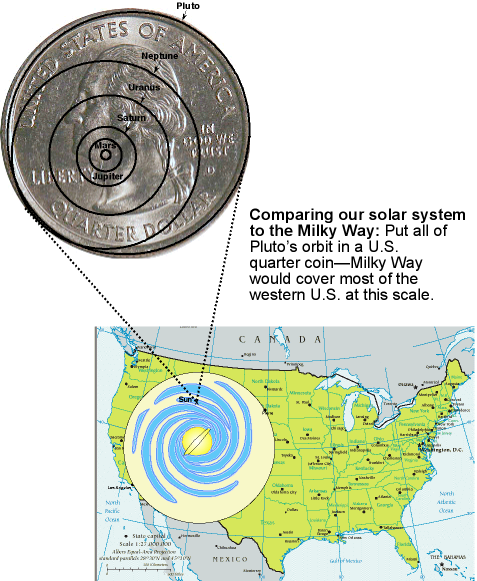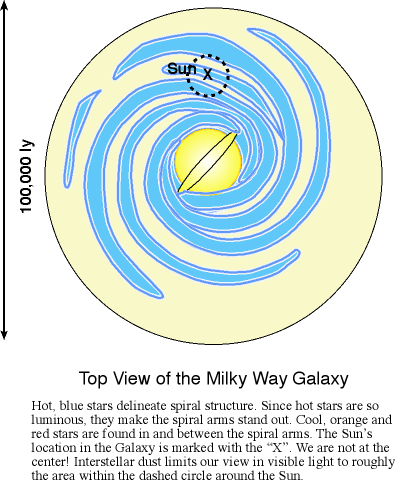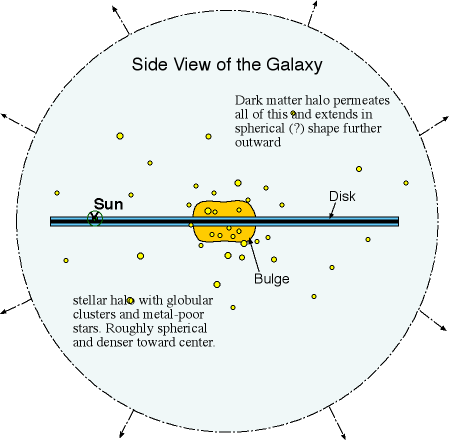
This material (including images) is copyrighted!. See my copyright notice for fair use practices. Select the photographs to display the original source in another window.
Determining the structure of our galaxy is not an easy task because the
solar system is
stuck inside the Galaxy and we can only look in all different directions. Our
situation is like you having to determine the layout of your hometown from
just looking out on your front porch (or back porch) and not being able to
move even across the street. The
fact that you see a narrow band of stars tells you that our galaxy is shaped
like a thin disk. If we lived in a more spherical galaxy, the stars would be
distributed more uniformly across the sky. If we lived in an irregular galaxy, there would be
patchier distribution of material in various parts of the sky instead of the narrow band of stars. There is a hint of a bulge
in the direction of the Sagittarius constellation (toward the Galaxy center). Careful star counts and
determining their distances shows hints of a spiral pattern in the disk. The
interstellar dust limits our view a small section of the Galaxy.
However, clear evidence of the spiral structure in the disk comes from the
21-cm line radiation discussed in the previous
section.
Our galaxy, the Milky Way, is disk-shaped with spiral arms in the disk. It has an elliptical bulge in the center with a bar-shaped distribution of gas/dust/stars going through the middle out of which the spiral arms extend and a spherical halo of stars that is denser closer to the Galaxy center. The disk of stars is about 100,000 light years across but only about 1000 light years thick (the dust layer is even thinner). The bar going through the middle of the bulge is about 25,000 by 4000 light years in dimension. Our solar system is about two-thirds of the way out from the center in a spur off one of the major spiral arms. For comparison, our solar system with the Oort Cloud is about 1 light year across. If Pluto's orbit were fit inside a U.S. quarter coin (so 80 AUs scaled to 24.26 mm), the Oort Cloud would be about 19 meters across, the next star system (Rigel Kentaurus & companions) would be about 84 meters away and the Galaxy would be about 1920 kilometers across (select the figure below to bring up a larger version).

You can make a rough guess of the number of stars in our galaxy by dividing the Galaxy's total mass by the mass of a typical star (e.g., 1 solar mass). The result is about 200 billion stars! The actual number of stars could be several tens of billions less or more than this approximate value. The disk contains over 98% of the dust and gas in the Galaxy. The bulge is made of a few tens of billions of stars while the stellar halo that extends out from it contains several hundreds of millions of stars. Most of the globular clusters are in the stellar halo and, like the halo stars, the number of them increases toward the galactic center. Astronomers have discovered that most of the mass of the Galaxy (and other galaxies) is not in the form of stars, gas, or dust. It is made of some other material, as yet unknown, and is given the descriptive name ``dark matter''. Note that this affects your guess of the number of stars in the galaxy! (Does it increase the number or decrease it?) The dark matter halo may extend out two or three times the extent of the stars.


Our galaxy probably closely resembles the galaxy NGC 891 as seen edge-on. Note the prominent dust lanes going through the disk mid-plane and how flat the galaxy is.

![]() Go back to previous section --
Go back to previous section --
![]() Go to next section
Go to next section
last updated: June 27, 2022